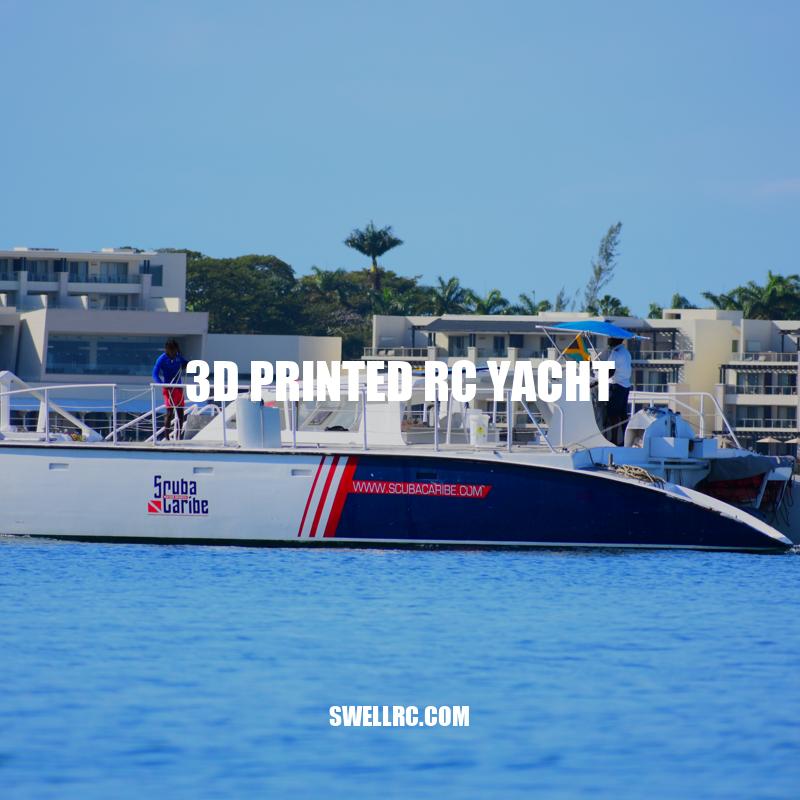Revolutionizing RC Boats: The Advantages of 3D Printed Yachts
3D printing has revolutionized many industries, providing a cost-effective and efficient way to manufacture products. The world of remote-controlled boats has been no exception, with enthusiasts turning to 3D printing to create custom-designed RC yachts. A 3D printed RC yacht is a sleek and stylish watercraft that can be created using a variety of printing materials, from biodegradable options to more traditional plastics. The ability to create intricate designs in a speedy manner, coupled with its durability, is what makes 3D printing so appealing to RC boat enthusiasts. This article will delve into the features and benefits of 3D printed RC yachts and the materials used, explain the design and printing process, and examine the potential for future advancements in this exciting area of RC boat production.
The Benefits of 3D Printed RC Yachts
There are several benefits to 3D printed RC yachts, making them an ideal option for RC boat enthusiasts. Below are some of the most notable advantages:
- Customization options for the customer’s needs and preferences, including the size and design of the boat
- Cost-effective production, as traditional boat-building methods can cost a significant amount of money and take much longer
- Speedy creation of intricate designs, thanks to the precise nature of 3D printing technology
- Strength and durability, as 3D printing can create watercraft that are more robust and able to withstand rough conditions than boats produced through traditional methods
Ensuring the highest quality 3D printed RC yachts through thorough design and printing processes, takes skill, expertise, the right equipment, and often a lot of time. Luckily there are many resources on the internet regarding both boat design and 3D printing. Websites like Thingiverse, for example, offer an impressively large catalog of 3D printable RC boat designs, including yachts. Often, you can use these designs as a base for your own customizations, saving you a considerable amount of time and effort researching your own boat designs.
Materials for 3D Printed RC Yachts
There are many materials used for 3D printing, so it is vital to select the right material specifically for RC yachts. Here are some of the most common materials used for 3D printed RC yachts:
- PLA (Polylactic Acid) – a biodegradable thermoplastic polyester derived from renewable resources like corn starch or sugarcane
- ABS (Acrylonitrile Butadiene Styrene) – a widely used thermoplastic polymer known for its toughness and impact resistance
- Polycarbonate – well-suited for high-stress applications, more rigid than other types of plastics
- Nylon – high strength when printed and stress resistance compared to other plastics
It is important to note that many 3D printing filaments aren’t inherently waterproof, so while these materials may work for 3D printed boats, additional coatings will be required to prevent water damage. Companies, such as Nanotech, have developed waterproof coatings specifically made for 3D printed parts for a range of uses, including for boats.
Below is a comparison table of different filament properties.
| Filament Type | Melting Point (⁰C) | Tensile Strength (MPa) | Elongation at Break (%) |
|---|---|---|---|
| PLA | 175-230 | 44-54 | 6 |
| ABS | 210-240 | 30-45 | 3-5 |
| Polycarbonate | 240-270 | 55-75 | 75-125 |
| Nylon | 220-250 | 50-100 | 40-200 |
What is the best material for a yacht?
When it comes to choosing the best material for a yacht, there are a few options to consider. Here are some popular materials and their pros and cons:
| Material | Pros | Cons |
|---|---|---|
| Fiberglass |
|
|
| Aluminum |
|
|
| Steel |
|
|
| Wood |
|
|
Ultimately, the best material for a yacht will depend on the owner’s preferences, budget and intended use. Websites like YachtWorld and BoatTrader offer a wide selection of yachts made from different materials.
The Design Process
The design process for a 3D-printed RC yacht involves using software that enables intricate customized designs. Here’s how it works:
- The designer uses a software program, such as Autodesk Fusion 360 or SolidWorks, to create a 3D model of the boat.
- The designer can refine the model’s shape, size, and weight distribution to optimize the boat’s performance.
- Customization options can include everything from the colors to the boat’s specific components.
- Once the design is complete, the model is sent to a 3D printer to be printed.
The software used in the design process is significant to the outcome of the final product. One highly rated software program for 3D printing is SketchUp, which has a wide range of potentials for design, including functionality, scale modeling, and rearrangement and movement of objects in 3D space. Additionally, Thingiverse is a popular website for 3D printing designs with a wide array of boats available for download.
It is essential to note that the design process may take significant amounts of time, from days to weeks, depending on the complexity of the design, and the available design skills of a user. However, with increased demand for 3D printing services and e-commerce platforms like Shapeways’ Designer Marketplace, there are more opportunities to access custom 3D printed designs.
Once a 3D model of the RC yacht is created, the printing process can begin. Here’s how it works:
- The 3D printer reads the digital model and starts printing layer-by-layer.
- The printing material is melted and extruded through a nozzle, which moves back and forth across the print bed according to the instructions from the slicer software.
- The printed object is slowly built up layer-by-layer until the yacht is completed.
- The printing process can take between several hours to several days, depending on the size and complexity of the model.
- Once the yacht is printed, finishing touches, such as sanding and painting, can be applied to achieve the desired look and finish.
There are several types of 3D printing technologies available, including Fused Deposition Modeling (FDM), Stereolithography (SLA) and Selective Laser Sintering (SLS). In FDM technology, the printers are affordable and easy to operate, making them ideal for hobbyists. SLA technology can print at a finer resolution, and the printed parts have a smoother surface finish and higher detail. SLS printers can print in various materials, including metal, and can create complex geometries.
There are also websites such as Shapeways that offer 3D printing services to create custom RC yacht designs. Such websites can provide a range of possibilities, including personalized scale models, unique shapes and sizes, and personalized decorations, thanks to their scanning capabilities. Furthermore, several e-commerce platforms provide boat designs suitable for 3D printing, including 3D Warehouse, STLFinder and Cults3D.
What is a model of a boat?
A model of a boat refers to a smaller replica of a boat that can be used for display, hobby, or as a collectible item. Most boat models are made with high-quality materials to ensure accurate detailing and precision. These models can range from simple designs to complex and intricate ones. There are different types of boat models, including sailboats, motorboats, and even ships. There are various websites and products that cater to boat model enthusiasts; for instance, Modelers Central, WoodenModelShipKit, and Amazon.
The Future of 3D Printed RC Yachts
Advancements in 3D printing technology continue to revolutionize the RC boat industry. Here are some possible ways that 3D printing will shape the industry in the future:
- On-demand 3D printing could reduce or eliminate the need for large-scale manufacturing of RC boats. This could lead to more affordable and accessible boats for consumers.
- 3D printing could enable the creation of complex, intricate designs that were previously impossible through traditional manufacturing methods.
- 3D printing allows for experimentation with new materials and designs, expanding the possibilities of what RC boats can do.
- As the technology improves, the cost of 3D printing is expected to decrease, making it more accessible to hobbyists and small businesses.
As the technology advances, it is expected that 3D printed RC boats will become more prevalent in the industry. Endless possibilities for customization and sustainability benefits, due to reduced production waste, are at the forefront of this technology advancement.
Moreover, the internet is an essential tool for 3D printing enthusiasts who want to learn more about the technology and create their own designs. Websites such as Thingiverse, MyMiniFactory, and Pinshape provide a multitude of printable RC boat models, including RC yachts. Additionally, design software such as Tinkercad and Fusion 360, offers hobbyists and designers the ability to create their own designs to share and print. With all of these resources readily available, it is no surprise that 3D printing paves the way for the future of RC boats.
How 3D printing is changing industry?
3D printing is transforming the manufacturing industry through a variety of ways:
- Prototyping – Companies can now quickly create 3D printed prototypes to test and tweak designs before mass production, saving both time and money.
- Customization – With 3D printing, companies can create customizable products at a lower cost and within a shorter period of time. This is especially useful in industries such as medical and dental where customized solutions are often required.
- Reduced Waste – 3D printing allows for products to be produced on-demand, resulting in less waste and lower inventory costs.
Moreover, 3D printing is also changing the supply chain industry by reducing the need for traditional transportation and storage methods. Companies like Shapeways and Sculpteo provide 3D printing services that allow individuals and businesses to easily design and print high-quality products. Overall, 3D printing is disrupting traditional manufacturing processes and providing new possibilities for innovation.
Conclusion
In conclusion, 3D printing has revolutionized the way RC boats are designed, built, and produced. Its benefits, such as customizability, cost-effectiveness, and strength, make it an attractive option to hobbyists and manufacturers alike. The future of 3D printed RC yachts looks promising, with endless possibilities for experimentation and customization.
As 3D printing becomes more accessible, it is expected that more hobbyists and small businesses will be able to use the technology to create their own designs. Access to online resources, communities, and software will continue to play a vital role in driving the innovation of 3D printed RC yachts.
Overall, 3D printing is not only opening up new opportunities for the RC boat industry but is also transforming manufacturing industries worldwide in ways never thought possible. With the continued growth and development of 3D printing technology, the future for RC yachts looks bright.



